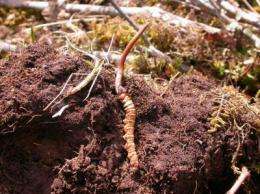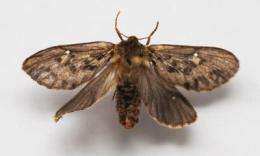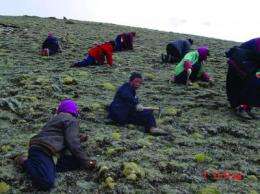Researchers identify insect host species of a famous Tibetan medicinal fungus

A team of researchers from the Institute of Microbiology, Chinese Academy of Sciences (Xiao-Liang Wang and Yi-Jian Yao), summarized all the available information on the insect species associated with the Tibetan medicinal fungus Ophiocordyceps sinensis through an extensive literature survey and analyzed their relationships with the fungus. The study was published in the open access journal ZooKeys.
The fungus has traditionally been used as a tonic to strengthen the human body and in the treatment of kidney and lung problems. It has also been shown to possess a variety of medicinal effects by recent studies, e.g. immunomodulating, hypocholesterolemic, hypoglycemic, anti-tumor, anti-oxidation and anti-aging activities. Natural products of O. sinensis is now sold at a price higher than the gold. The fungus contributes billions of RMB (Chinese yuan) to the rural economy in Tibet Plateau each year and often accounts for some 70% of a local family's annual income. Thousands and thousands of collectors crowd into the Tibet Plateau every summer, causing a sharp decrease in the natural production of O. sinensis and serious damages to the environment.

"Ophiocordyceps sinensis (also Cordyceps sinensis), known as the Chinese Caterpillar Fungus or 'Dong Chong Xia Cao' (winter worm, summer grass) in Chinese, is one of the most widely recognized traditional Chinese medicines. The fungus is endemic to the Tibetan Plateau and has been listed as an endangered species under the second class of state protection since 1999 by the Chinese government. The fungus has a striking developmental biology. As a Sac (ascomycete) fungus, it parasitizes larvae of moths of the family Hepialidae and converts them into sclerotized bodies from which the fungus fruiting body grows. So the natural production of this fungus is closely related to its insect hosts." said the corresponding author Prof. Yi-Jian Yao.
Since the late 1950s, much effort has been devoted to the study of insect species related to O. sinensis in China. However, the number of insect host species of O. sinensis and the relationship between those insects and the fungus remains unclear.

In the study by Wang and Yao, a total of 4793 related publications, in either English or Chinese, were obtained and analyzed. Ninety-one insect names spanning 13 genera of Chinese Hepialidae moths were gathered from the literature search, together with the detailed information of their geographic distribution and altitude. The relationships between the reported insect species and O. sinensis were analyzed based on the overlap of their geographic distribution and altitude range. Fifty-seven of these insects are considered as recognizable potential host species of the fungus, whilst eight are considered as indeterminate hosts and 26 as non-hosts.
The results of this study provide basic information for management of the insect resources and for the conservation and sustainable use of O. sinensis. It will lay a foundation for further studies of the relationship between the fungus and its hosts, especially their co-evolution (an ongoing research project based on DNA sequence analyses in Prof. Yao's laboratory).
More information: Host insect species of Ophiocordyceps sinensis: a review. ZooKeys 127: 43-59. doi: 10.3897/zookeys.127.802
Provided by Pensoft Publishers
















